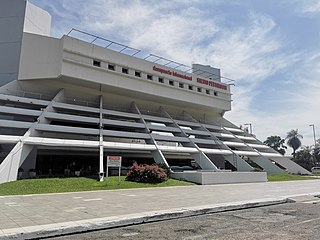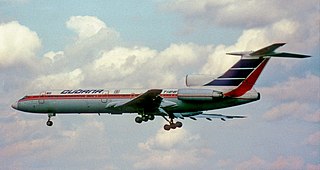
TAME or TAME EP Linea Aerea del Ecuador was an airline founded in Ecuador in 1962. TAME was the flag carrier and the largest airline of Ecuador. TAME headquarters were in Quito, Pichincha Province and the main hub was Mariscal Sucre International Airport in Quito. The airline was formed by the Air Force of Ecuador. In 2011, it became a commercial entity and provided domestic, international and charter flights. On May 20, 2020, the Ecuador government decided to cease all the operations and liquidate the airline.
This is a list of aviation-related events from 1960.

The Fairchild F-27 and Fairchild Hiller FH-227 were versions of the Fokker F27 Friendship twin-engined, turboprop, passenger aircraft manufactured under license by Fairchild Hiller in the United States. The Fairchild F-27 was similar to the standard Fokker F27, while the FH-227 was an independently developed, stretched version.

Cancun International Airport is located in Cancún, Quintana Roo, on the Caribbean coast of Mexico's Yucatán Peninsula. It is Latin America's third and Mexico's second busiest airport, after Mexico City International Airport. In 2021, Cancún airport handled 22,318,467 passengers, and 30,342,961 passengers in 2022 according to Grupo Aeroportuario del Sureste.

Icaro Air was an airline based in Quito, Ecuador. Its main base was Mariscal Sucre International Airport, Quito.

Mariscal Sucre International Airport was the main international airport serving Quito, Pichincha Province, Ecuador. It was the busiest airport in Ecuador by passenger traffic, by aircraft movement and by cargo movement, and one of the busiest airports in South America. It was named after Venezuelan-born Antonio José de Sucre, a hero of Ecuadorian and Latin American independence. It began operations in 1960, and during its last years of operation, handled about 6.2 million passengers and 164,000 metric tons of freight per year. The airport, one of the highest in the world was located in the northern part of the city, in the Chaupicruz parish, within five minutes of Quito's financial center; the terminals were located at the intersection of Amazonas and La Prensa avenues. Mariscal Sucre International was the largest hub for TAME with an average of 50 daily departures.

Silvio Pettirossi International Airport is an international airport in Luque, Paraguay, which serves Paraguay's capital city, Asunción, and indirectly serves the nearby city of Clorinda, Formosa in Argentina. The airport is named after Paraguayan aviator Silvio Pettirossi. Between 1980 and 1989, it was known as President Stroessner International Airport, after the former head of state, Alfredo Stroessner. Pettirossi handled 1.24 million passengers in 2019, making it the busiest airport in the country. It is the main international hub for LATAM Paraguay and Paranair.
SAETA Air Ecuador was a privately held airline of Ecuador, which was founded in 1966. During its heyday in the 1990s, it flew to numerous destinations in North and South America from its base in Guayaquil.

EP Petroecuador is the national oil company of Ecuador. Ecuador who is a member of the Organization of the Petroleum Exporting Countries (OPEC) and, although it is the smallest member, the country produced 531,000 barrels of crude oil per day in 2019. The oil corporation is a significant part of the Ecuadorian economy. The petroleum industry has expanded to the production of refined commodities such as gasoline, liquefied petroleum, and jet fuel. The government of Ecuador is highly dependent on the revenues from the energy sector to support its budget and finance state projects.

AOM French Airlines was the second-largest airline in France from 1988 until 2001. Its head office was in Building 363 at Orly Airport, Paray-Vieille-Poste.

Mariscal Lamar International Airport is a high elevation airport serving Cuenca, the capital of the Azuay Province in Ecuador. It is named after the Peruvian military leader and politician José de la Mar, a native of Cuenca.
SAN was an airline which was based in Guayaquil, Ecuador that was the domestic branch of the airline SAETA. It was founded in 1964, and ceased operations in 1999.

TAME Flight 120 was a Boeing 727-134 airliner, registration HC-BLF, named El Oro, operating as a scheduled international passenger flight between Quito, Ecuador and Cali, Colombia, with a scheduled stopover at the Ecuadorian border town of Tulcán. The aircraft crashed while on approach to Tulcán's Teniente Coronel Luis A. Mantilla International Airport on January 28, 2002. The pilot flew the approach incorrectly in reportedly foggy conditions, and the aircraft crashed into the side of the Cumbal Volcano, located near Ipiales, Colombia, at 10:23 in the morning. All passengers and crew were killed in the crash.
Chachoan Airport is a high elevation airport serving Ambato, capital of the Tungurahua Province in Ecuador. The airport is 6 kilometres (3.7 mi) northeast of Ambato, in a broad basin of the central Andes mountains cut through by the Ambato River.

The 1983 TAME Boeing 737 crash is the deadliest aviation accident in Ecuador. A Boeing 737-2V2 Advanced, operated by Ecuador's national airline, flying on a domestic route from the now-closed Mariscal Sucre International Airport in Quito to Mariscal Lamar Airport in Cuenca, crashed into a hill during final approach just 1 mile from its final destination, killing all 119 people on board.

Central American Airways Flight 731 was a passenger flight which crashed on approach to Toncontín International Airport, Tegucigalpa, Honduras, on February 14, 2011. All 14 on board died. The aircraft involved, a Let L-410 Turbolet, was operating Central American Airlines' scheduled domestic service from San Pedro Sula to Tegucigalpa.

Mariscal Sucre International Airport is an international airport serving Quito, Ecuador. It is the busiest airport in Ecuador and one of the busiest airports in South America. It is located in the Tababela parish, about 18 kilometres (11 mi) east of Quito and serves as the largest hub for Avianca Ecuador and LATAM Ecuador. It also served as the main hub for TAME, Ecuador's flag-carrier, before the airline was liquidated by the Ecuadorian government in 2020. The airport opened in February 2013 and replaced the 53-year old airport of the same name. The airport is named after independence leader Antonio José de Sucre. It is rated as the only 5-star airport in the Western Hemisphere by Skytrax.

Cubana de Aviación Flight 389 (CU389/CUB389) was a scheduled international passenger flight, flying from the former Mariscal Sucre International Airport in Quito to La Habana's José Martí International Airport, with a stopover at Simón Bolívar International Airport in Guayaquil, operated by Cuban flag carrier Cubana de Aviación.

Malév Flight 110 was a scheduled flight from Budapest-Ferihegy Airport to Borispol Airport. On 16 September 1971, the Tupolev Tu-134 (HA-LBD) crashed near Kiev-Borispol Airport, Ukraine, due to poor visibility conditions, killing all 49 passengers and crew on board. The crash of Flight 110 was Ukraine's third worst airplane crash at the time, and as of 2022, the 10th worst in Ukraine.

On 23 April 1979, SAETA Flight 011, a Vickers Viscount passenger aircraft of Ecuadorian airline SAETA, crashed in a mountainous region of Pastaza Province, Ecuador, killing all 57 people on board. The wreckage of the aircraft was not found until five years later.

















